#fred foss
Text
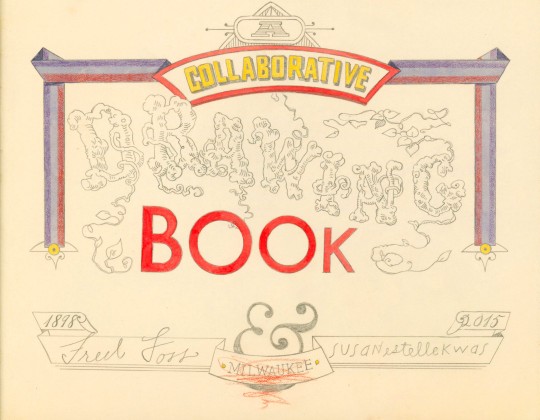


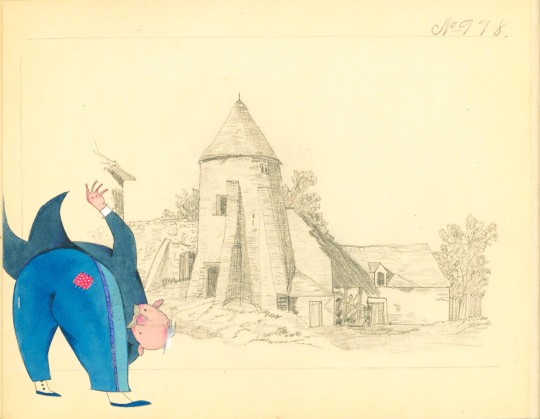
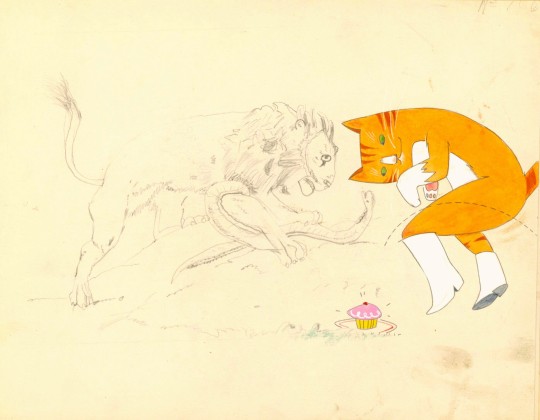





Staff Pick of the Week!
Susan Estelle Kwas is a Milwaukee artist known for her vibrant illustrations and whimsical artist books. Her 2015 publication, A Collaborative Drawing Book is no exception as it invites readers into a visual conversation between Milwaukeean Fred Foss (1898) and Kwas (2015) over one hundred years in the making.
Kwas found Foss’ copy book in an antique shop and was so delighted by his graphite drawings that she decided to pair them with her own. Sometimes tucking characters into Foss’ scenery, other times superimposing them, Kwas’ colored pencil and watercolor contributions are nothing short of charming.
Kwas rebound the book in montage sur onglets form (with pages sewn on stubs to release them from the confines of the gutter) in buffalo leather, preserving the original orientation of each page. The cover decoration was created by blind tooling inset leather strips and is complimented by marbled endpapers.
View other staff picks here.
– Jenna, Special Collections Graduate Intern
#staff pick of the week#susan estelle kwas#a collaborative drawing book#fred foss#blind tooling#montage sur onglets#marbling#drawing#watercolor#Milwaukee aritsts
29 notes
·
View notes
Text

#musical theater#do you know this musical#poll#chicago#john kander#fred ebb#kander and ebb#bob fosse#language: english
66 notes
·
View notes
Text
Have you seen this musical?
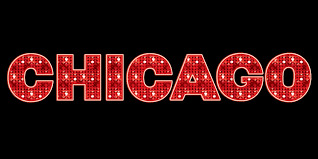
#chicago musical#chicago the musical#bob fosse#fred ebb#musical theater#theatre poll#musical theatre#musicals#theatre
5 notes
·
View notes
Text
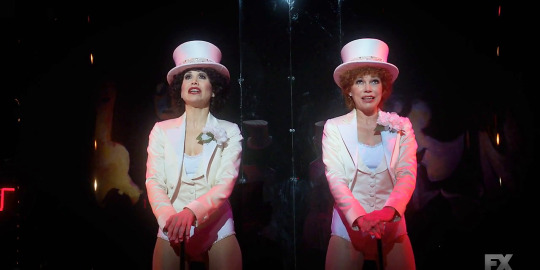

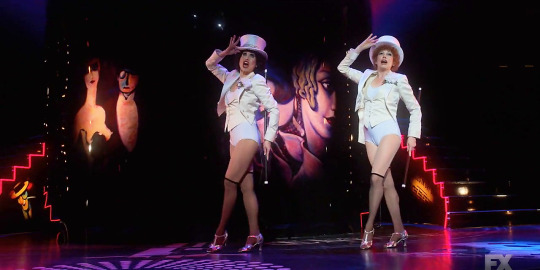
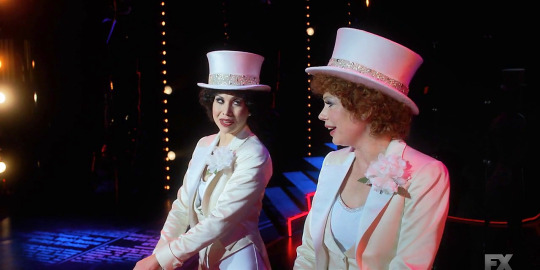
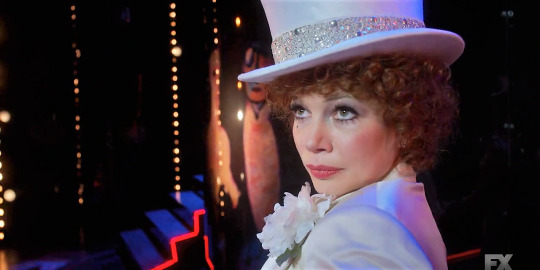
Michelle Williams as Gwen Verdon and Bianca Marroquín as Chita Rivera performing "Nowadays" from the Broadway musical "Chicago" in the 2019 FX miniseries "Fosse/Verdon"
#chicago#michelle williams#gwen verdon#bianca marroquin#chita rivera#velma kelly#john kander and fred ebb#musical theater#fosse/verdon#nowadays#roxie hart
43 notes
·
View notes
Text
I have strong feelings about productions of Chicago and how they often sand off the very seedy edges of Chicago and sex it up - because sex sells. Which is, of course, very ironic given what the show is actually trying to do. Given that the show is talking about false sex and glamour as a beacon in lives of sordid crime, with said sex and glamour an abstract vaudeville space, it seems mad to sell the show on precisely what it's critiquing. But that original Broadway cast recording hits the nail on the head - it has everything. Listen to the very opening song.
Listen to the pure JAZZ in that vocal! Up front, Chita Rivera - a rightful legend - tells us that we are going to see parody for the next two hours. Make no mistake, this is a Jazz Age parody. And, too, we are going to have a huge amount of fun with it. She brings such archness to this number, such knowingness to the form of the musical, that it allows the audience to have one eye on the plot and another on the form. An absolute masterclass in performing with an eye on the show as a whole, not just your character, and why she is one of the best leading ladies of the last 100 years!
3 notes
·
View notes
Photo
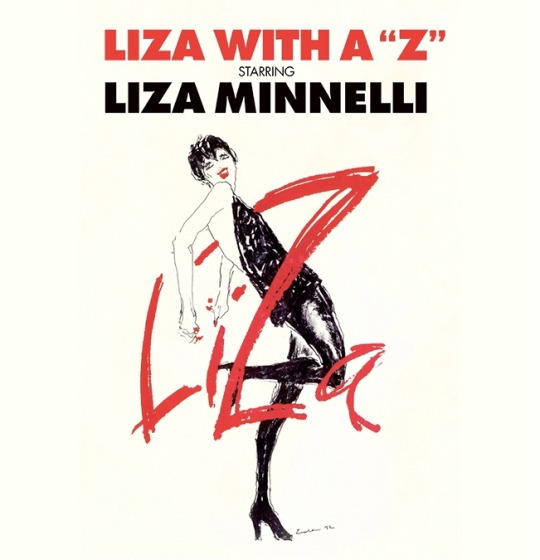
Den Geburtstag unserer guten, alten Hausmuse mit einem “Z” haben wir natürlich auch feierlich begangen, mit Bob Fosses legendärem Fernsehkonzert alle Fernsehkonzerte zu beenden, gleich nachdem sie das Konzept erfunden hatten. Ist jetzt auch über 50 Jahre her, funktioniert aber immer noch schön. Hoch soll sie leben!
1 note
·
View note
Text
Chicago (2002) - Nowadays / Hot Honey Rag (Türkçe Altyazılı)
youtube
#jack kander#fred ebb#danny elfman#bob fosse#nowadays/hot honey rag#renée zellweger#catherine zeta jones#chicago#musical#noir thriller#jazz age#flappers#rob marshall#2002#Youtube
1 note
·
View note
Text

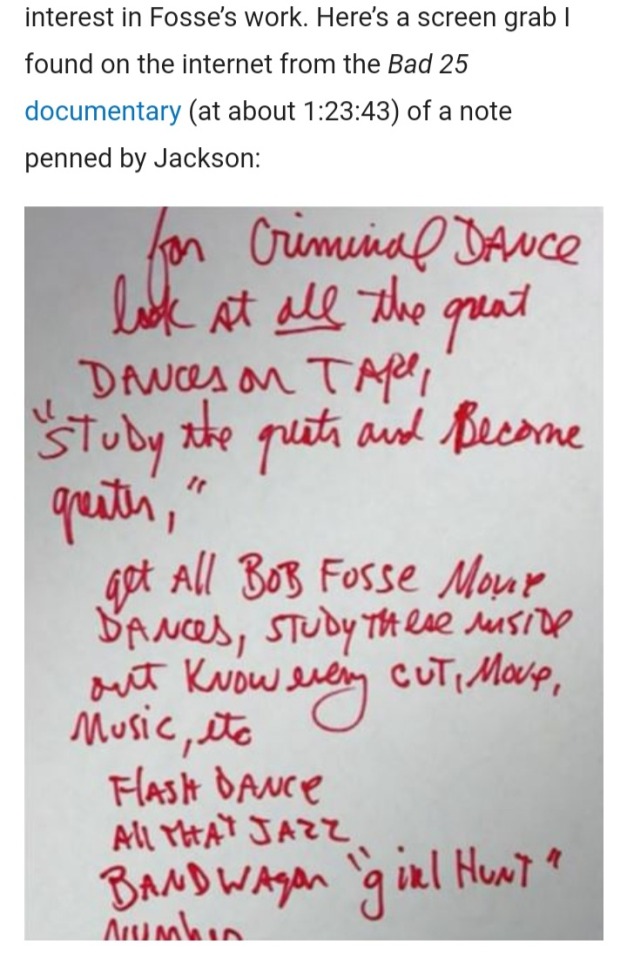
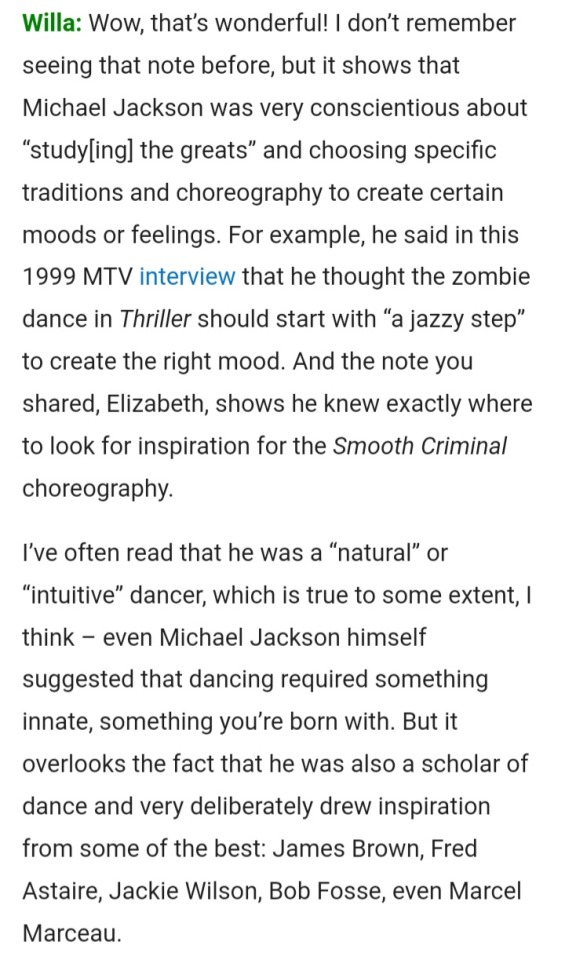







He was also presenting himself as a conduit of black culture, New York's in particular. It was a bid for authenticity, an attempt to tap into the street culture of America's most famous black neighborhood.
So while he acknowledged that he didn't invent the moonwalk, as you pointed out, he didn't cite his specific teachers, and Pugh seems to think it was to give himself some street cred "at a time when hiphop, which did come out of New York streets, was threatening to outshine his own work.
Elizabeth: I don't completely discount Megan Pugh's read on this because I think the commercial context Jackson operated within has to be considered as an influence on his work. I argued in an unpublished conference paper that "Bad" capitalized on the edgy associations of street culture in the late 80s.
#mj#michael jackson#bob fosse#fred astaire#dance#vernon castle#critical essay#brenda dixon-gottschild#africanist#nicholas brothers#dance critic#john w. sublett#john w. bubbles#megan pugh#american dancing from the cakewalk to the moonwalk#book#books#soul train#black culture#new york#casper candidate#jeffrey daniel#damita jo freeman#bill bailey#eleanor powell#james brown
0 notes
Text



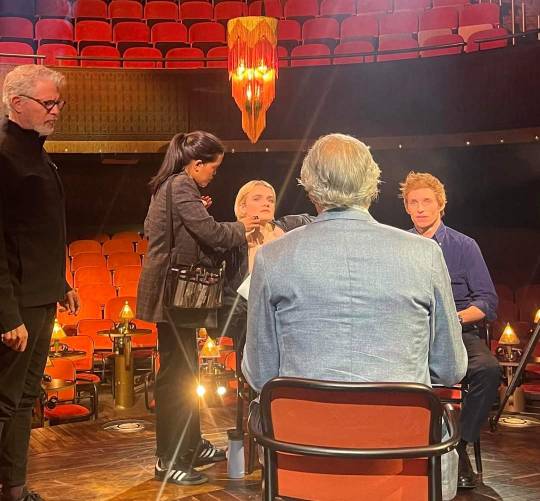

New! Cabaret at the kit kat Club NYC> Sunday Morning CBS' new interview upcoming !
📷 Credit: Sunday Morning on CBS News Producer Jay Kernis on Facebook : "If all goes well, on this week’s Sunday Morning Mo Rocca looks at the enduring popularity of the John Kander/Fred Ebb musical "Cabaret," from its debut in 1966 and the Oscar-winning Bob Fosse film, to the latest revival on Broadway, in a production titled "Cabaret at the Kit Kat Club." Correspondent Mo talks with actors Eddie Redmayne (who plays the Emcee), Gayle Rankin (Sally Bowles) and Bebe Neuwirth (Fraulein Schneider), and with designer Tom Scutt, about their goal of immersing the audience in the story".
#eddie redmayne#eddieredmayne#redmayne#cabaret 2024#gayle rankin#bebe neuwirth#august wilson#mo rocca#sunday morning#cbs news
20 notes
·
View notes
Text

Did I Say that?
n/a: Tenho qu admitir que não gostei tanto desse one shot, e que gostaria de ter desenvolvido um pouco mais. Maaaas, espero que vocês me perdoem e gostem dele mesmo assim kkkk Boa leitura!
Número 4 da lista de diálogos: "estou hipnotizado com a sua beleza".
Contagem de palavras: 1,493
— Não quero arrancar esses dentes. — Zayn reclamou pela centésima vez na mesma ligação, me fazendo revirar os olhos. — Fred Mercury não arrancou os dele! — Disse indignado.
— Os dele não causavam dor. Além disso, não vai interferir em nada no seu alcance vocal, todos os dentistas e os fonos te disseram isso. — Falei me sentando no sofá.
— Você vai mesmo ficar aqui comigo depois? — Disse agora manhoso.
— Eu já prometi que vou, e vou te alimentar com muito sorvete.
Eu entendia o medo de Zayn em retirar os dois dentes sisos, sua última experiência com extração não foram muito boas. Mas agora ele tinha como pagar os melhores dentistas do mundo inteiro, o que era muito melhor do que sofrer de dor e viver se entupindo de todo tipo de remédios para diminuir o desconforto.
Perto do horário da consulta me dirigi para a clínica como o combinado, e lá estava ele, encostado no carro e pálido como se tivesse visto um fantasma.
— Você não vai me gravar quando estiver chapado, vai? — Perguntou apertando o botão do elevador para o andar indicado.
— É claro que eu vou. — Cruzei os braços. — E vender para o site de fofoca que pagar mais. — Provoquei, fazendo-o revirar os olhos.
Antes de entrar para a sala, Zayn me entregou seu celular e as chaves do carro. O procedimento não durou mais do que quarenta minutos, e quando entrei na sala ele estava com as bochechas cheias de algodão, falando coisas desconexas. Já munida com a câmera virada pra ele, sorri me aproximando.
— s/n. — Disse meu nome de maneira engraçada e arrastada. — Vofê tá tão bonifa. — Ele disse me fazendo rir. O médico me entregou um remédio que poderia dar a ele caso sentisse dor após o efeito do anestesico se dissipar.
Zayn entrou no banco do passageiro, observando as tatuagens em seus braços como se nunca tivesse as visto.
Assim que entramos no apartamento amplo, ele tirou a camisa, me fazendo pegar o telefone mais uma vez para observar pela câmera o que ele faria.
— Onde você vai?
— Fomar banho. — Falou como se fosse óbvio, virando para me olhar. Mesmo com os olhos caídos de tão chapado, e as bochechas cheias de algodão conseguia continuar lindo. Zayn definitivamente é um dos preferidos de Deus.
— Mas você está limpinho. — Debochei.
— Mas eu gosto de banho. — Ele disse dando ênfase na palavra e gesticulando com as mãos. — E tá calor demais. — Ele agora tentava abrir o cinto, sem muito sucesso. Então formou um beiço com o lábio inferior e me olhou. — Colaram meu cinto, s/n, nunca mais vou tomar banho. — Se jogou no sofá, me fazendo dar uma risada. — Para de rir. É um assunto fério. — Seus olhos se encheram de lágrimas, me fazendo ficar com dó. Desliguei o vídeo e larguei meu celular no sofá, me sentando ao seu lado.
— Não quer um sorvete antes do banho?
— Não. — Maneou a cabeça com força de um lado para o outro algumas vezes. — Quero um banho. De banheira. — As sobrancelhas unidas demonstravam que ele começava a se irritar com seu próprio estado.
Me dei por vencida, e avisei que iria colocar a banheira para encher. Zayn me seguiu até seu quarto, se livrando dos tênis pelo caminho e os deixando por lá. Regulei o calor da água e o encontrei no quarto sentado na cama, ainda lutando contra o cinto.
— Eu te ajudo. — Falei me abaixando em sua frente e tirando suas mãos de cima da fivela.
— Sempre quis que você tirasse a minha roupa. — Ele disse rindo consigo mesmo, fazendo meu corpo travar com a frase. Fingi não ouvir, sabendo que podia ser só o efeito do sedativo. O ajudei a se livrar das calças e voltei ao banheiro, desligando a água que ainda caia.
Me virei ao ouvir os passos se aproximando do banheiro, e travei novamente quando o observei, totalmente nu a minha frente. Já havia visto Zayn de cueca muitas vezes, mas nunca totalmente despido. Porra, definitivamente um o preferido de Deus.
Tentando ignorar o homem devastador de tão lindo, o ajudei a entrar na banheira, e sentei sobre a tampa do vaso sanitário.
Zayn tirou os algodões na boca, fazendo uma careta de nojo e os jogou no chão, me fazendo segurar o riso. Ele tentou lavar os cabelos, mas sua falta de coordenação não estava deixando.
Sentei na borda da banheira e levei minhas mãos no lugar das suas, massageando seu couro cabeludo e fazendo espuma.
— Você é tão bonita. — Ele disse enquanto eu tirava o resto de shampoo com a ducha. — Eu fico hipnotizado com a sua beleza.
— Zayn. — Falei em tom de aviso. Tentando controlar meu coração pulando dentro do peito. Comecei a passar o creme em seu cabelo.
— Adoro quando diz o meu nome. — Ele fechou os olhos. — Fica tão bem na sua boca. — Suspirei alto, tentando mais uma vez controlar a pulsação. Ele abriu um sorriso de lado, piorando ainda mais a minha situação. — Quando você tá brava faz ficar melhor ainda. — Ele riu pelo nariz. — Por isso eu te irrito, só pra ouvir meu nome sair da sua boca linda.
— Acho melhor você sair daí. — Falei afastando minhas mãos do seu cabelo, e ele abriu os olhos com a falta de contato. Por mais que estivesse ainda sob o efeito da anestesia, seus olhos estavam com um brilho diferente, e eu podia ver a ereção crescente entre a espuma. Tentei me levantar para pegar a toalha pendurada no box, mas, curiosamente, as mãos de Zayn foram mais rápido, agarrando em minha cintura e me puxando para dentro da banheira, me deixando ensopada, ainda mais do que eu já estava por dentro da roupa.
— Zayn! — Gritei atônita. Fazendo-o sorrir com satisfação. — Você é um idiota. — Grunhi, tentando sair, mas ele me apertava em seus braços.
— E você é linda. — Eu sentia minhas bochechas aquecerem cada vez mais. Cada parte do meu corpo totalmente molhada, incluindo meus pés ainda dentro dos tênis. — Sou louco por você, desde aquele dia que você me xingou por esbarrar em você. — Uma das mãos molhadas passeava em meu rosto, o sangue em minhas veias correndo rápido demais.
— Vamos sair, por favor. — Pedi em um fio de voz. Zayn suspirou alto, insatisfeito, mas afrouxou o aperto e me deixou sair.
Me enrolei na toalha, e alcancei outra para ele. Enquanto Zayn se dirigia ao quarto para se vestir, me livrei das roupas molhadas e me enrolei na toalha novamente.
Encontrei o moreno deitado sobre as cobertas da cama, apagado e roncando levemente. Não consegui conter o sorriso, e peguei dentro de seu armário uma camiseta e uma cueca, torcendo para que minhas roupas secassem antes que ele acordasse.
Zayn acordou apenas na manhã seguinte, reclamando de dor. Lhe dei os analgésicos e servi uma taça de sorvete como café da manhã.
— Fiz muita besteira ontem? — Ele perguntou depois da terceira colherada.
— Você me fez te dar banho, e me puxou para dentro da banheira.
— É sério? — Ele perguntou erguendo as sobrancelhas.
— Você não lembra de nada? — Tentei esconder meu descontentamento. Havia passado a noite toda pensando se falava ou não sobre as suas declarações da noite passada.
— Não. — Disse coçando a cabeça. Tomei o restante do café que havia em minha xícara em um gole só, e me virei para a pia, jogando água dentro dela.
— Como você já está melhor, acho que já vou indo… — Falei forçando um sorriso. Zayn se levantou de sua cadeira e se aproximou um pouco, apoiei minhas costas na pia para observa-lo.
— Eu disse alguma coisa que te magoou? Você parece chateada.
— Não… você não disse nada demais. — Dei um sorriso amarelo, soltando a risada pelo nariz.
— Eu te conheço. O que eu disse ontem? — Zayn apoiou as mãos tatuadas na pia atrás de mim, me deixando presa em seus braços, os olhos castanhos fixos nos meus fazendo meu coração bater muito além do aceitável.
— Você disse… que é louco por mim. — Admiti, fazendo-o tornar sua expressão em incredulidade. — Mas tudo bem, eu sei que era efeito da anestesia. — Tentei empurra-lo, mas Zayn não se mexeu, me mantendo muito perto.
— s/a, me desculpa, eu… — Ele mordeu o lábio inferior, como se estivesse escolhendo as palavras certas.
— Zayn, está tudo bem. — Dei de ombros.
— Não está não. — Ele suspirou. — Precisei ficar chapado pra te dizer o que estava entalado há meses. — Bufou. — Idiota.
— Entalado a meses? — Perguntei, para ter certeza de que havia ouvido certo.
— Sim, desde que esbarrei em você aquele dia. — Fitou os próprios pés. — Eu sei que não é a mesma coisa com você, mas… — Coloquei meu dedo indicador sobre seus lábios, fazendo com que ele me olhasse.
— Eu juro que se não fosse o risco dos seus pontos estourarem agora, eu beijava você. — Praticamente sussurrei, fazendo-o sorrir embaixo do meu dedo.
— Tenho certeza de que com cuidado não tem mal nenhum. — Ele disse puxando minha mão para baixo, e colando nossos lábios em um beijo casto.
55 notes
·
View notes
Text




Life Is a Cabaret! The Shimmering Kander and Ebb Classic Heads Back to Broadway Starring Eddie Redmayne
BY ADRIENNE MILLER
PHOTOGRAPHY BY JULIEN MARTINEZ LECLERC
STYLED BY HARRY LAMBERT
March 5, 2024
When I was 15 years old, I saw Cabaret for the first time, at a community theater in northeast Ohio. Though I considered myself sophisticated in important ways (I recall that I was wearing a wide-leg Donna Karan bodysuit that evening), my experience as a theatergoer was then limited to The Sound of Music and Ice Capades: Let’s Celebrate. I wonder if my parents, who had season tickets to the theater, knew that the show wasn’t exactly “family” entertainment. Set in 1931 Berlin as it careens toward the abyss, Cabaret depicts alternating stories. There’s the doomed romance between a fledgling novelist named Clifford Bradshaw and a young singer of supreme charisma (and mediocre talent) named Sally Bowles. And then there’s the seedy nightclub, the Kit Kat Club, which is populated with a highly sexualized cast of misfits and overseen by a ghoulish Master of Ceremonies. The show’s ethos—the glamour and terror, the irreverence, the campiness, the unreality—shaped my taste forever, and I knew that I had just experienced one of the greatest works of art ever created. I would never look at theater, or life, in the same way again.
Over three decades later, I’ve seen more stage productions of Cabaret than any other show, including a revival starring the original Emcee, Joel Grey; I’ve seen the Bob Fosse film version over 50 times. I’ve pretty much always got one of Fred Ebb’s sardonic lyrics jangling around in my head. Today, it’s “You’ll never turn the vinegar to jam, mein Herr,” and I couldn’t agree more.
Youthful exposure to Cabaret also turned out to be a life-changing event for the star of the new production opening this month on Broadway, Eddie Redmayne. “Weirdly, when I was 15, it was the first thing that made me believe in this whole process,” he says. Redmayne was a student at Eton when he first played the Emcee; he had never seen Cabaret when he was cast. On this late-autumn evening, Redmayne is speaking to me from Budapest, where he is shooting a TV series. “It reaffirmed my love for the theater,” he says of his first experience. “It made me believe that this profession, were I ever to have the opportunity to pursue it, was something that I wanted to do.”
Now, as he prepares for the transfer of the smash-hit 2021 London production of Cabaret (in which he also starred), Redmayne is reflecting on the power and durability of the John Kander and Fred Ebb masterpiece. “The show was just so intriguing and intoxicating,” he says, adding that the character of the Emcee posed many questions when he portrayed him for the first time, but provided scant answers. A few years later, when he was an art-history student at Cambridge, he again tackled the part of the Emcee at the Edinburgh Festival Fringe. At a dingy performance space called the Underbelly, he did two shows a night, the audiences getting rowdier and more intoxicated throughout the evening. He’d get up the following afternoon and stand along Edinburgh’s Royal Mile handing out flyers for the show, dressed in latex. “There was just a sort of general debauchery that lived in the experience,” he says. When his parents came one night, they were alarmed to find that their son had turned into a “pale, lacking-in-vitamin-D skeleton.”
Flash forward 15 years. The Underbelly cofounders and directors, Charlie Wood and Ed Bartlam, would approach Redmayne—now with an Academy Award for The Theory of Everything and a Tony for Red under his belt—with the idea of again playing the Emcee. Redmayne was eager to return to the role, but many questions remained—principally, who might direct it. In 2019 he happened to have been seated in front of the visionary young director Rebecca Frecknall at the last performance of her West End production of Tennessee Williams’s Summer and Smoke. It was an emotional evening for Frecknall, who’d been working on the project on and off for a decade. She and Redmayne were introduced, but “I had mascara down my face and probably didn’t make a very coherent first impression,” she tells me from London, where her new show, The House of Bernarda Alba, has just opened at the National Theatre.
Redmayne was astonished by the depth and delicacy of understanding that Frecknall brought to Summer and Smoke, a romance with the classic Williams themes of loneliness, self-delusion, and unrequited love. A few months later, Redmayne asked Frecknall if she’d consider directing a revival of Cabaret. “I said, ‘Of course I’ll do it, but you’ll never get the rights,’ ” she recalls. Those rights were held up with another production but were shortly thereafter released, and Frecknall went to work assembling her creative team—among them musical supervisor Jennifer Whyte, choreographer Julia Cheng, and set and costume designer Tom Scutt. Frecknall’s transcendent production of Cabaret opened on the West End at the tail end of the pandemic and succeeded in reinventing the show anew, winning seven Olivier Awards, including one for Redmayne and one for Frecknall as best director.
When Cabaret begins its run in April at the August Wilson Theatre, starring Redmayne, Gayle Rankin, Bebe Neuwirth, and Ato Blankson-Wood, it will be just the second major production of the show directed by a woman. (Gillian Lynne directed the 1986 London revival.) In Frecknall’s version, Sally emerges as the beating heart of the show. “I find that most of my work has a female protagonist,” says Frecknall, who has also directed radical new interpretations of A Streetcar Named Desire, Chekhov’s Three Sisters, and Romeo and Juliet. “And I have a different connection to Sally,” she says. “I was really drawn to how young she was…and how she uses that sexuality and how other people prey on that as well.” The role of Sally Bowles, originated in this production by Jessie Buckley, who also won an Olivier for her performance, will be played this spring by the brilliant Scottish actor Gayle Rankin.
“When I first met with Gayle, I was blown away by her passion and fearlessness,” says Frecknall. “She’s a real stage animal and brings a rawness and wit to her work, which will shine through. She’s going to be a bold, brutal, and brilliant Bowles.” Redmayne also praises Rankin for the depth of emotion she brings to the part, and for the vulnerable and volcanic quality of her interpretation.
Rankin arrives at a candlelit West Village restaurant on a chilly winter evening in a sumptuous furry white coat that would put Sally Bowles to shame. Her platinum hair is pulled back from her face and her dark blue eyes project a wry intelligence. Rankin lives near the restaurant and mentions that she has recently joined a nearby gym—not that she’s going to have much time for workouts in the coming months. Over small seafood plates (of her shrimp cocktail, she shrugs and concedes, “It’s a weird order, but okay”), she shares her own rich history with Cabaret.
She grew up in a small Scottish village, watching Old Hollywood movies with her mother and grandmother. At 15, she left home to attend a musical theater school in Glasgow; on her 16th birthday, she visited New York for the first time with her family. “It sounds like a cheesy, made-up story,” she says, but when she and her parents took a tour of the city on a double-decker bus, they passed by the Juilliard School. “I thought,” she says, “ ‘I am going to go there.’ ” The following year, she and her father flew from Glasgow to New York for her audition. She would become the first Scottish drama student to attend the institution.
At Juilliard, there’s an annual cabaret night, in which all third-year drama students perform songs. Rankin sang “Don’t Rain on My Parade” from Funny Girl, but she recalls her acute sense that she could have chosen a number from Cabaret. “I think I secretly always wanted to be that girl,” she says of the classmate who did perform those songs.
A couple of years after she graduated Juilliard in 2011, Rankin’s agents approached her with an opportunity to audition for Sam Mendes’s 2014 revival of his celebrated 1998 Broadway version (first staged in London in 1993), with Alan Cumming reprising his Emcee role. She was cast as Fräulein Kost—an accordionist sex worker who is revealed as a Nazi—playing opposite a revolving cast of Sallys, including Michelle Williams and Emma Stone.
Rankin has recently emerged as a fierce presence in films and in television (The Greatest Showman and two HBO series—Perry Mason and the upcoming season of House of the Dragon), but then “it kind of came across my desk this summer to throw my hat in the ring for Sally.” How does Rankin make sense of this fascinating, mystifying character? “Everything is so sort of up for grabs…. People feel as if they have a claim over her or know who she is. And the real truth is, only Sally gets to know who Sally is.” She has been rereading Christopher Isherwood’s 1939 semi-autobiographical novel Goodbye to Berlin—the inspiration for the show—in which the English writer sets the dying days of the Weimar Republic against his relationship with the young singer Sally Bowles. (In 1951, the playwright and director John Van Druten adapted the book for the stage with I Am a Camera; in 1963, Broadway director-producer extraordinaire Harold Prince saw that the play could be musicalized and hired Joe Masteroff for the libretto and the songwriting team of Kander and Ebb.) Isherwood based Sally—somewhat—on Jean Ross, a British flapper and chanteuse who later became a well-regarded film critic, war correspondent, political thinker, and Communist. (He gave the character the last name of writer and composer Paul Bowles.) For the rest of her life, Ross maintained (correctly) that Isherwood’s portrayal of her diminished her reputation as an activist and as an intellectual.
“Ross wanted so badly to write to Isherwood,” says Rankin, “and to condemn him: ‘You slandered my name. You said all these things about me that weren’t true.’ And as far as she got in the letter was ‘Dear Christopher.’ ” As Rankin builds the character, it’s this notion of the real Sally—not the fictive version constructed by Isherwood—that she finds so captivating, and heartbreaking.
The upending of Sally as an “object” is another core conceit behind the production. “I felt that other productions I’d seen had this slightly stereotypical male-gaze idea,” Frecknall says. She views Sally’s musical numbers as describing different facets of female identity. “Don’t Tell Mama” deals with the fetishization of youth and virginity, and in Frecknall’s production, Sally, disturbingly, appears in a sexy Little Bo Peep costume; “Mein Herr,” a song about manipulation, control, and female sexual desire, is in conversation with the cliché of the strong, “dominant” woman. “I think Sally’s very clever at being able to play an identity, and also play it against you,” she adds. The character “has secrets to tell us,” Rankin says. “Important things to share with us. And I think that’s the umbilical cord between her and the Emcee.”
Although Sally and the Emcee share the stage for less than five minutes, the Emcee’s musical numbers can be seen as a kind of meta-commentary about Sally’s actions. “What interested me was the idea that the Emcee was a character created by Hal Prince and Joel Grey,” says Redmayne, referring to the actor who portrayed the Emcee in the original 1966 production. “He doesn’t exist in the book Goodbye to Berlin and was their conceit to connect the story of Sally Bowles.” Rankin believes that there is a kind of mystical bond between the two characters. “As to whether or not he’s a higher power, or higher being, he does have an access to a higher knowledge,” Rankin suggests. “I think Sally feels that too.”
And who is the Emcee? A supernatural being? Puppeteer or puppet? There are no clues in the text. Prince conceived of the character as a metaphor representing Berlin itself. “The idea of him as an abstraction,” Redmayne says, “and so purposely intangible, meant that I actually found a new way of working.” Redmayne built the character from the ground up, starting with big, broad gestures that would be gradually refined. The “very fierce, ferocious intensity” of Herbert von Karajan, the famously dictatorial Austrian conductor of the Berlin Philharmonic and a Nazi party member, served as a particularly fertile inspiration.
Historically, the role of Emcee has been coded as gay, and embodied, in most prominent productions, by gay actors. Frecknall’s production had to address what it meant to cast Redmayne, a straight white male actor, in the role. “Tom [Scutt] and I felt very clearly that, well, it’s not going to be the Emcee’s tragedy,” Frecknall says. A person like Redmayne—given his class, ethnicity, and sexuality—would emerge from the catastrophe unscathed. Redmayne concurs: “As the walls of fascism begin to close in, he has the privilege to be able to shape-shift his way out of it.” The character’s journey is from Shakespearean fool to Shakespearean king.
In Hal Prince’s 1966 production, Grey’s delicate, meticulous performance as the cane-twirling Emcee is pure nihilism—as a representation of Germany’s conscience. In the later Mendes iteration, the Emcee emerges as the central victim: In that production’s chilling last scene, Alan Cumming’s louche Emcee removes a black trench coat to reveal a concentration camp uniform; a burst of bright white light follows, from, presumably, a firing squad. But in Frecknall’s version, the Emcee is exposed not as a victim of the system, but as the chief perpetrator. The show, she notes, “becomes the ensemble’s tragedy.”
“I was really intent that we cast it very queer and inclusive,” says Tom Scutt, Cabaret’s multitalented set and costume designer. We are sitting on a black banquette in the lobby of his hotel, across the street from Lincoln Center, where he’s working on Georges Bizet’s Carmen. To mount a revival of Cabaret in 2024, Scutt contends that “there’s no other way. That was really at the headline of our mission.”
There are two casts in the show: the main company and the prologue cast, which provides pre-curtain entertainment. In general, the members of the prologue cast don’t come from traditional musical-theater backgrounds, but from the worlds of street dance and hip-hop—“dancehall, voguing, and ballroom scene,” Scutt notes—and in the London production, some of the prologue performers have been promoted to the main cast. “There is something deeply, deeply moving about how we’ve managed to navigate the usual slipstream of employment.”
Part of Scutt’s intention with Cabaret has been to “smudge and diffuse’’ the audience’s preconceived notions. Inclusive casting is one mode for change; iconography is another. In this case, that has meant no bowler hats, no bentwood chairs, no fishnet stockings. The aesthetic is less Bob Fosse and more Stanley Kubrick. “We started off in a place of ritual,” he says. “I really wanted the place to feel as if you’ve come into some sort of Eyes Wide Shut temple.”
Scutt has reimagined the 1,250-seat August Wilson Theatre as an intimate club—warrens of labyrinthine new corridors and passageways, three new bars, and an auditorium reinvented as a theater-in-the-round. Boris Aronson, the set designer of the show’s iconic original 1966 production, suspended a mirror on the stage in which the audience members would see their own reflections—a metaphor that forced the audience to examine its own complicity; but in Scutt’s design, the audience members must look at one another. Access to the building is through a side entrance; as soon as you arrive, you’ve already lost your bearings.
In many ways, it’s remarkable that such a weird and complex work of art masquerading as a garishly entertaining variety show has had such longevity. Scutt has an explanation about why this piece—created by a group of brilliant Jewish men about the rise of antisemitism and hate, about the dangers of apathy—continues to speak to us so profoundly almost 60 years after its Broadway debut.
“I can’t really think of anything else, truly, that has the same breadth of feeling in its bones,” Scutt suggests. “I honestly can’t think of another musical that does so much.” As grave, and as tragically relevant, as the messages of Cabaret are, he and the members of the company have found refuge in theater. Both Scutt and Frecknall grew up singing in their churches as children; theater is to them a secular church, a space where human beings can congregate and share healing. “It was made with such pain and such love,” Scutt says. “Which is absolutely the piece.”
In this story: hair, Matt Mulhall; makeup, Niamh Quinn. Produced by Farago Projects. Set Design: Afra Zamara.
#eddie redmayne#gayle rankin#vogue magazine#the emcee#sally bowles#broadway#nyc#Julien Martinez Leclerc photographer#harry lambert#styling#best actor#oscar winner#olivier awards winner#obe#talent#new article#photoshoot
9 notes
·
View notes
Text

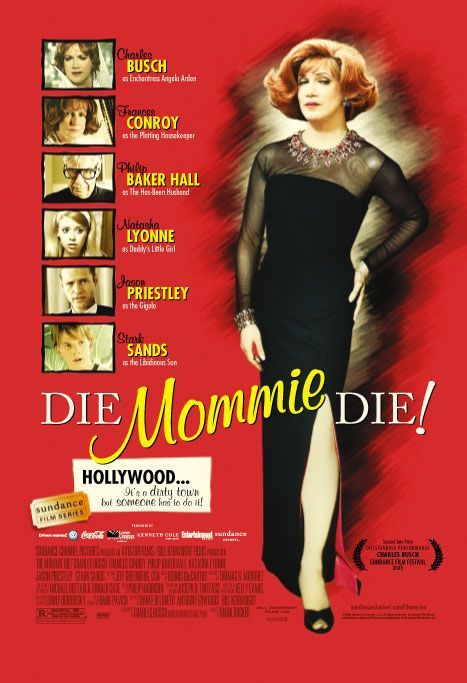

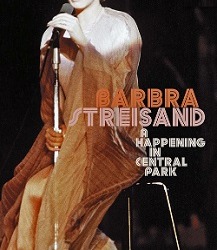
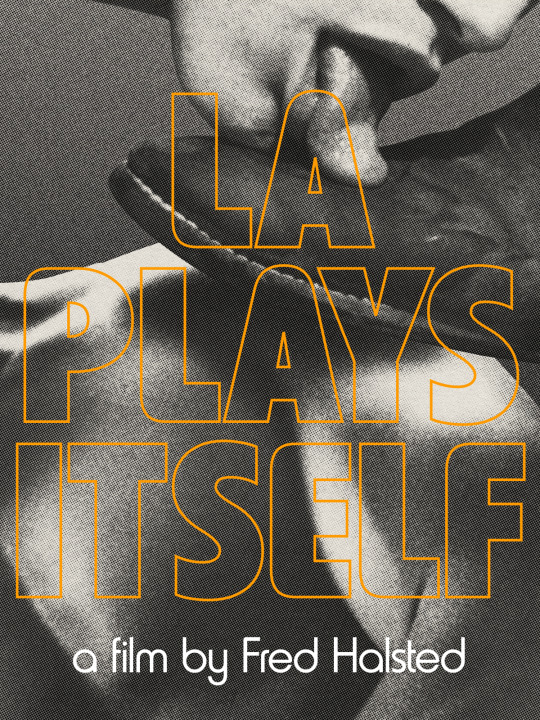
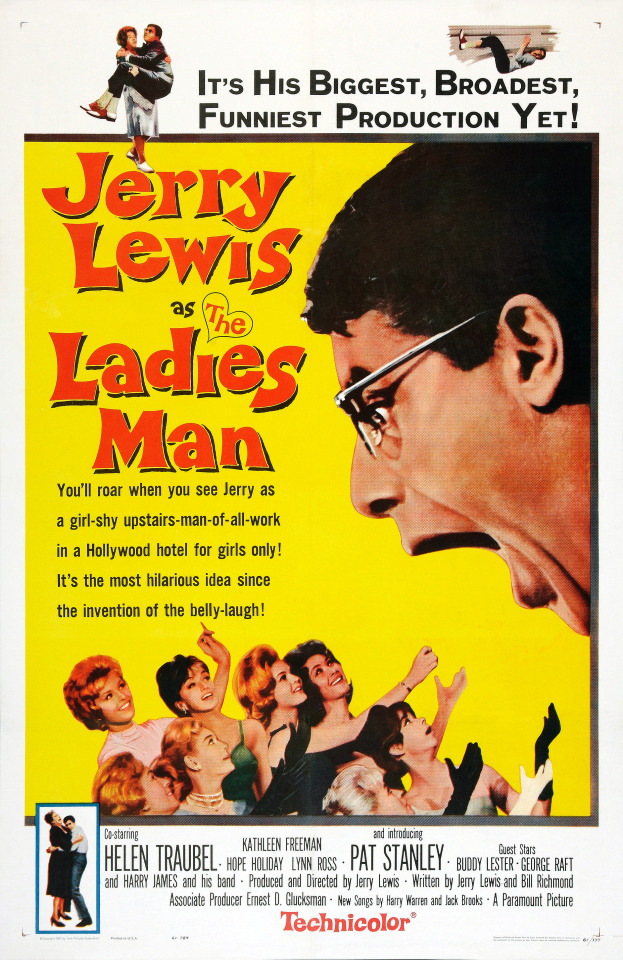

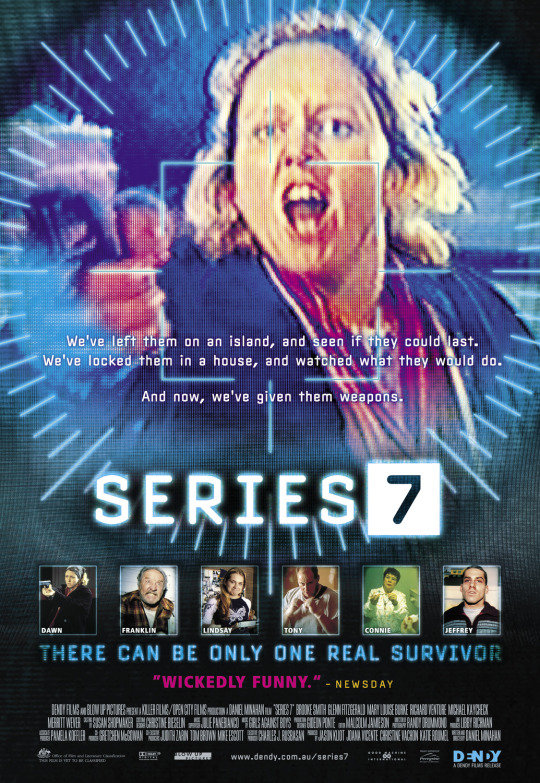
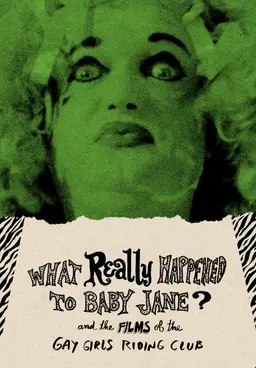
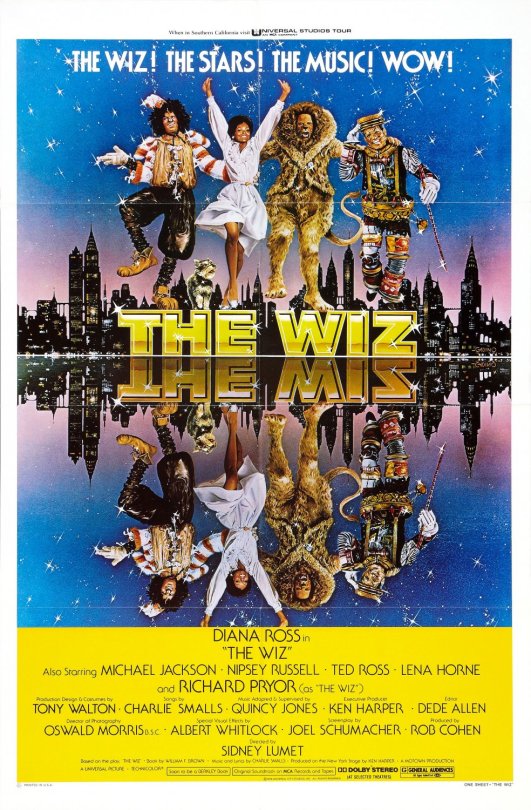
New To Me - 2023
All About Alice (1972, Ray Harrison)
Bambi (1942, David Hand)
Die, Mommie, Die! (2003, Mark Rucker)
Dreams (1990, Akira Kurosawa)
Elephant (1989, Alan Clarke)
Erin Brockovich (2000, Steven Soderbergh)
Glen or Glenda (1953, Edward D. Wood Jr.)
A Happening in Central Park (1968, Robert Scheerer)
In Vanda’s Room (2000, Pedro Costa)
LA Plays Itself (1972, Fred Halsted)
The Ladies Man (1961, Jerry Lewis)
Morvern Callar (2002, Lynne Ramsay)
News from Home (1976, Chantal Akerman)
A Self-Induced Hallucination (2018, Jane Schoenbrun)
Series 7: The Contenders (2001, Daniel Minahan)
Single White Female (1992, Barbet Schroeder)
Terminal USA (1993, Jon Moritsugu)
What Really Happened to Baby Jane (1963, Ray Harrison)
The Wiz (1978, Sidney Lumet)
Zero Day (2002, Ben Coccio)
+++
2LDK (2003, Yukihiko Tsutsumi)
AM1200 (2008, David Prior)
Another Gay Movie (2006, Todd Stephens)
Black Book (2006, Paul Verhoeven)
Bloodbath at the House of Death (1984, Ray Cameron)
Bloody Muscle Body Builder in Hell (1995, Shinichi Fukazawa)
Caniba (2017, Lucien Castaing-Taylor & Véréna Paravel)
Charade (1963, Stanley Donen)
Close Encounters of the Third Kind (1977, Steven Spielberg)
The Color Purple (1985, Steven Spielberg)
Crimes of Passion (1984, Ken Russell)
Death to Smoochy (2002, Danny DeVito)
The Faculty (1998, Robert Rodriguez)
Foxfur (2012, Damon Packard)
The Fluffer (2001, Richard Glatzer & Wash Westmoreland)
Freeway (1996, Matthew Bright)
Girls Will Be Girls (2003, Richard Day)
Hotel (2004, Jessica Hausner)
The Idiots (1998, Lars von Trier)
The Inheritance (2020, Ephraim Asili)
Lady Gaga and the Muppets Holiday Spectacular (2013, Gregg Gelfand)
Mod Fuck Explosion (1994, Jon Moritsugu)
Ned Rifle (2014, Hal Hartley)
Pee-wee’s Playhouse Christmas Special (1988, Paul Reubens & Wayne Orr)
R100 (2013, Hitoshi Matsumoto)
The Salt Mines [1990] & The Transformation [1996] (Susana Aikin & Carlos Aparicio)
Seconds (1966, John Frankenheimer)
Sextool (1975, Fred Halsted)
Sibyl (2019, Justine Triet)
Spirited Away (2001, Hayao Miyazaki)
Star 80 (1983, Bob Fosse)
Strange Days (1995, Kathryn Bigelow)
Teknolust (2002, Lynn Hershman-Leeson)
Theorem (1968, Pier Paolo Pasolini)
18 notes
·
View notes
Text

#chicago#broadway#broadway musical#gwen verdon#chita rivera#jerry orbach#bob fosse#john kander and fred ebb#roxie hart
31 notes
·
View notes
Photo

Gary Flannery - photo by Roy Blakey for After Dark magazine
Gary Flannery is a professional performer who toured the world as Shirley MacLaine’s partner; was a Principal Dancer on many TV Shows and Hollywood movies; and was a lead dancer on Broadway in Pippin and Dancin', and in the movie All That Jazz (Bob Fosse called Gary “The Bull” for the sheer non-stop energy). Gary has studied with teachers including Antony Tudor, Martha Graham, Jose Limon, Stanley Williams, Alexandra Danilova, Anton Dolan, Lucas Hoving, Fred Benjamin, Chuck Davis, and Jaime Rogers. He received full scholarships to the School of American Ballet and Juilliard. Gary continues to teach master classes, lectures, and seminars at universities, dance schools and colleges around the world.
#gary flannery#ballet#ballet history#dance#dancer#danseur#ballerino#bailarín#boys of ballet#ballet men#broadway dancer#musical theatre
41 notes
·
View notes
Text

Storia Di Musica #299 - Sonic Youth, Daydream Nation, 1988
Il mese delle scelte con doppia voce cantante maschile e femminile termina con un disco epocale. E poche volte l'aggettivo calza a pennello come questa volta, in un disco, doppio, che accumula tutte le idee di una generazione del rock alternativo americano, per un lavoro discografico seminale da cui fioriranno artisti e idee prorompenti degli anni a venire. La storia degli artefici di questo disco inizia qualche anno prima, nel 1981, a New York. Al Noise Festival organizzato dalla galleria d'arte White Columns, quando Thurston Moore sta suonando con la sua fidanzata, Kim Gordon, e vengono notati dal comnpositore e musicista d'avanguardia Glenn Branca. Tra loro nasce subito un'intesa, e uno dei collaboratori di Branca, un chitarrista dalle idee molto originali, Lee Ranaldo, si unisce al gruppo, che una volta trovato un batterista, Richard Edson (ma ne cambieranno decine nel corso degli anni) formano un gruppo a cui danno un nome composto dal nome di Fred "Sonic" Smith, membro degli MC5 e fondatore della Sonic's Rendezvous Band e futuro marito di Patti Smith, con quello del musicista reggae Big Youth, amato da Kim Gordon: nascono così i Sonic Youth. Dopo un primi ep, titolato Sonic Youth, nel 1983 pubblicano il primo disco, Confusion Is Sex, nel 1983: portano sul vinile il selvaggio modo di esibirsi nei locali, tra feedback come se non ci fosse altro effetto musicale, rumorismo preso dalla lezione di Branca, tessiture di chitarra stranianti frutto delle accordature del tutto personali degli strumenti, riff minimali e ripetitivi, in una congestione tra punk e avanguardia che li renderà unici, aggiungendo quel tocco rock decadente tra Velvet Underground, Stooges e MC5, tanto amati da Moore. Sono anche super combattivi e non la mandano a dire a nessuno, e il primo ad accorgersene fu il famoso critico Robert Christgau, che sul Village Voice definì il loro suono e quello di altre band emergenti Pigfuck, alchè la band dedicò la sanguinosa e niente affatto edulcorata una nuova versione di Kill Yr Idols in I Killed Christgau With My Big Fucking Dick, prima che i due si riappacificassero. Il primo grande disco è del 1985, Bad Moon Rising, che in alcune canzoni, come gli otto minuti fatali di I Love Her All The Time e soprattutto Death Valley '69, epocale, fanno capire che nessuno è uguale a loro. Moore ha l'abitudine di cambiare di continuo metodi di registrazioni, anche lo stile di produzione, e di cambiare con la stessa frequenza batteristi. Evol del 1986 li lega all'etichetta SST, e dopo un altro album grandioso, Sister, del 1987, si cimentano in un progetto alternativo, chiamato Ciccone Youth, dove rifanno pezzi storici di Madonna, Robert Palmer e parodiano l'hip hop, che in quegli anni stava salendo alla ribalta. E qui hanno un incontro particolare: Nick Sansano è un produttore hip hop, che li vede suonare. Non ha mai prodotto rock, ma si innamora così tanto del loro modo vivo e potente di esibirsi che accetta di produrre il loro lavoro, registrato ai Greene St. Recording, a SoHo, New York. Moore cambia stile di "progettazione" e con la band, che alla batteria stavolta ha Steve Shelley, inizia a suonare jam session improvvisando, carpendo di volta in volta le parti più interessanti. per la prima volta, hanno mezzi economici e tecnici per registrare più tempo, e nel mese che si prendono per farlo scrivono tantissime canzoni, che vanno a finire in un doppio album che, come accennato, è uno dei grandi dischi degli ultimi decenni: Daydream Nation (1988).
È un disco densissimo di stili, significati, idee, e basta la copertina, un rifacimento con una candela reale del famoso quadro Kerze di Gerhard Richter, per capire che è un disco di fattura ideologica potentissima. È un disco che sperimenta ogni cosa, dal pop di Kissability alla potenza dei brani iniziali, le ormi leggendarie Teenage Riot (It's time to go 'round\A one man showdown teach us how to fail\We're off the streets now\And back on the road on the riot trail) e Silver Rocket. Le voci di Moore e Gordon si alternano ai brani, Kim è fantastica e intensa in Cross The Breeze, ma alterna altri registri vocali ed interpretativi, per una prova super dove si pone persino ironica in The Sprawl. Lee Ranaldo e la sua chitarra non sono mai stati così visionari come in Eric’s Trip che prende ispirazione dal monologo di Eric Emerson nel film Chelsea Girls di Andy Warhol e Hey Joni, un omaggio alla loro maniera fantasiosa di Hey Joe di hendrixiana memoria ma dedicata a Joni Mitchell e che nel testo allude al leggendario Neuromancer di William Gibson, il libro cult del cyberpunk. Un messaggio vocale con voce stentorea di Mike Watt dei Minutemen compariva quasi dal nulla in Providence con in sottofondo il piano suonato da Thurston Moore, assolo di piano registrato a casa di sua madre usando un walkman, il suono di un amplificatore Peavey Roadmaster surriscaldato e un paio dei suddetti messaggi telefonici lasciati da Mike Watt, che chiamava Moore da un telefono pubblico di Providence, Rhode Island, doppiati l'uno sull'altro. The Wonder si ispira ad una lavoro dello scrittore James Ellroy, maestro della crime fiction. Sul disco, in omaggio (o sberleffo) ai Led Zeppelin del mitico IV, ogni componente della band ha un simbolo che lo contraddistingue. Il disco è un'ovazione di critica e pubblico sin dall'uscita, e campeggia nelle prime posizioni dei dischi migliori dell'anno 1988. A distanza di anni, è unanimemente considerato il punto più alto del rock indipendente americano. Subito dopo, firmano con la Geffen, e come succede sempre, vengono accusati di altro tradimento dai fan della prima ora. Ma questa è un'altra storia, che nulla toglie alla bellezza e all'importanza storica di questo album capolavoro.
16 notes
·
View notes
Text
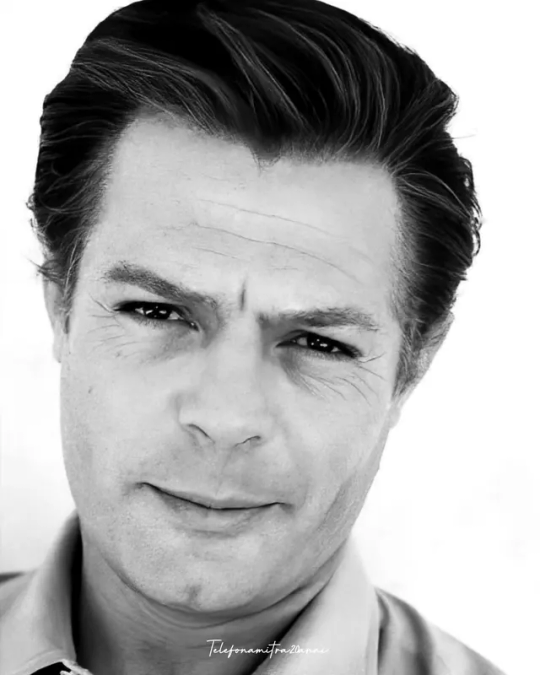
Giochiamo al se fosse?
I fumetti di Linus, il rumore del treno, le sigarette, la pasta e fagioli preparata amorevolmente, il telefono, l'architettura, gli Skyline Newyorkesi, Parigi, Roma, la neve, la pioggia, il mestiere d'attore, il cinematografo, il teatro, Ginger Roger & Fred Astaire, Anton Čechov, il preludio, un cuscino condiviso con una donna, la bellezza in genere, un quadro, l'arte, un bicchiere di cognac, la fedeltà di un cane, un ricordo, le scarpe, gli orologi, le macchine, un buon vestito di sartoria, viaggiare, il caffè, la casa, la vita.
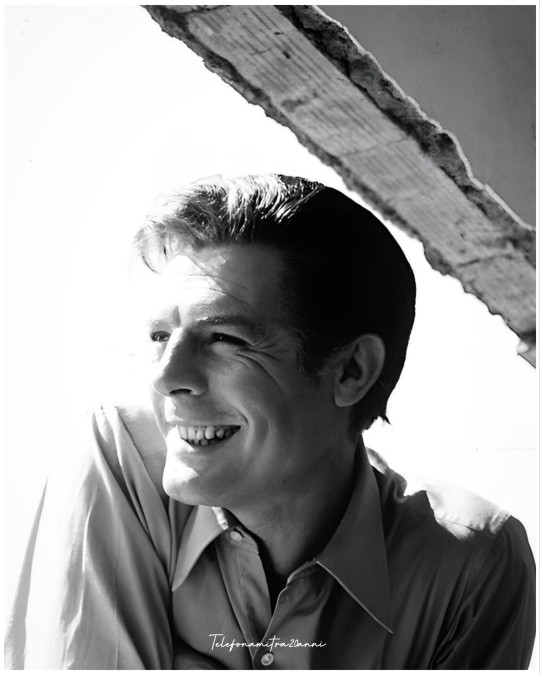
#marcello mastroianni#original photographers#film photography#mastroianni marcello gif#best actor#federico fellini#kodak#latin lover#movies#moviegifs#mastroianni marcello#mastroianni#sex symbol#marcellomastroianni#parisfrance#lo straniero#telefono#caffetteria#cafetime#italian cinema#italian style#telefonami tra vent'anni#telefonamitra20anni#la dolce vita#vita#caffeine#fred astaire#ginger
17 notes
·
View notes